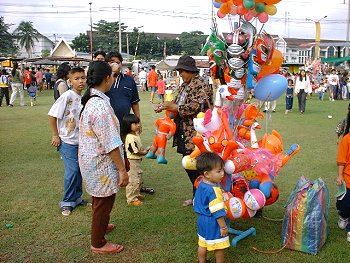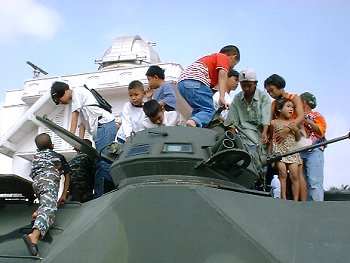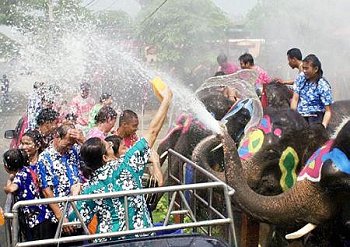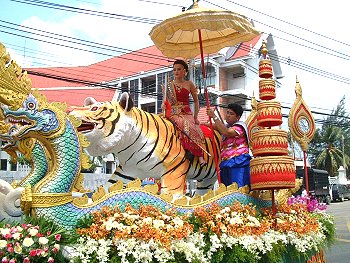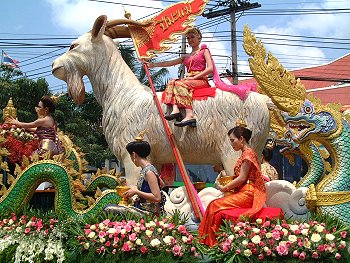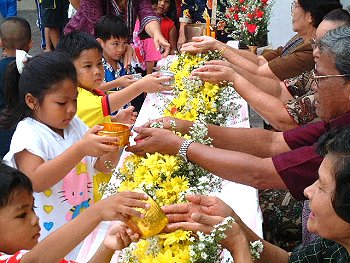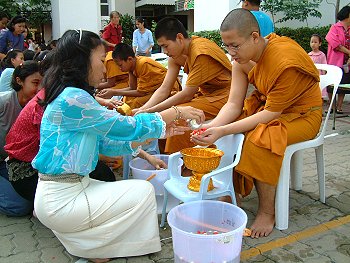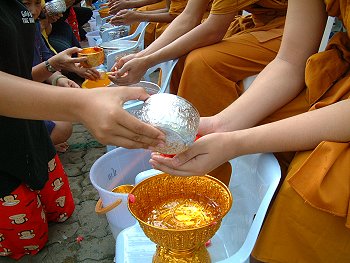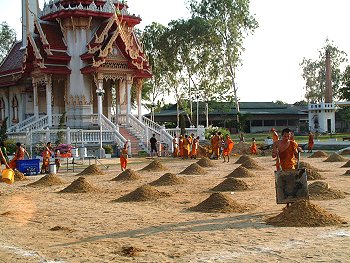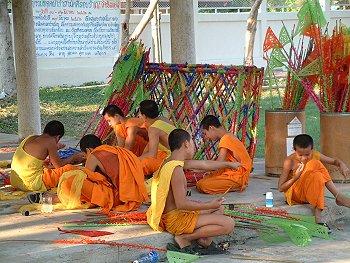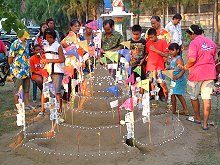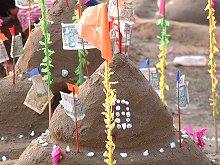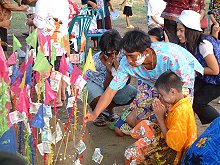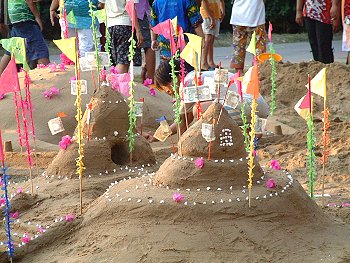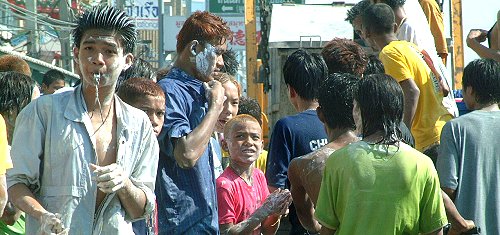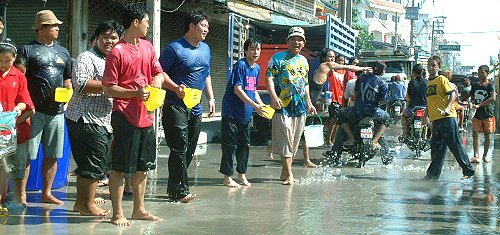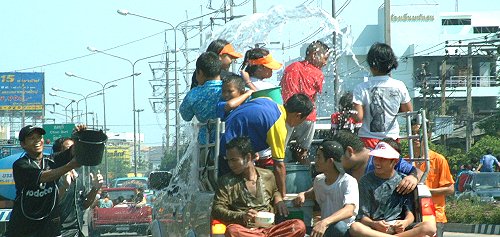Thai Culture - Festivals Adapted from: Thai Street Food in my Area by Gor (Panrit "Gor" Daoruang) a Thai Teenager and his webite:
|
|---|
The Thai's have many festivals - here are some of them
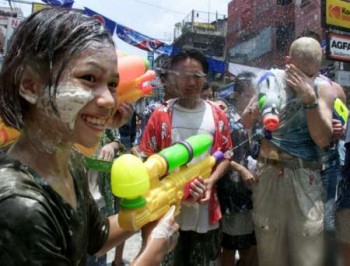

A Thai girl shoots a tourist with water gun in Khaosan Road during "Songkran festival" in the left picture. And in the right picture, Thai people dressed up as ghosts on Halloween day. Really this is not a Thai festival, we borrowed it from another country.
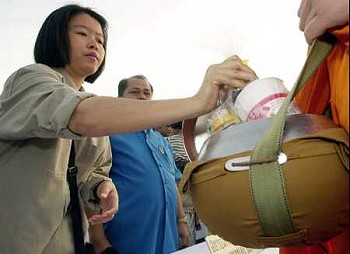
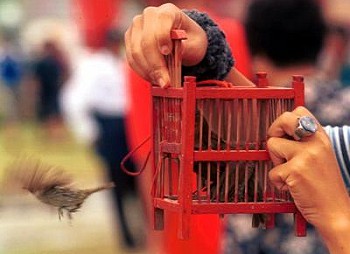
During most festivals, Thai people go to the temple to make merit.
Left picture: she is giving food to the monk. This only done in the morning.
Right picture: people let birds go free.The sounds of firecrackers can be heard exploding all over the place. Young happy children with 'Ang Pao' (red envelopes containing money) in hand and processions of dragon dancers make their way down the roads of Chinatowns around the world. They represent the coming of the Chinese New Year--the most important day on the Chinese calendar.
The Chinese New Year is also known as the Lunar New Year, is on the first day of the first month based on the Chinese style lunar calendar. Some people call New Year's day ‘The Spring Festival' because it is the beginning of spring.
Two days before New YearChinese people go to the market to buy food and other offerings on this day. It is also the last day for shops and stalls to open. All the shops will be closed until after the New Year.
The last day of the year
Chinese pray and prepare offerings to the gods and to their ancestors on this day. There are three different kinds of prayers that must be performed, including prayers for the Gods of the Land in the morning, prayers for the ancestors at noon and prayers for the wandering souls with no relatives in the afternoon.
These prayers show respect to the gods and ancestors. They believe that these prayers will bring merit and blessings. After each prayer, the Chinese burn golden paper, believing that the paper will become money in the after life.
New Year's day
More prayers are done on New Year's day, this time for the gods of luck and good fortune. This prayer is usually held in the early morning and you need to look at the ‘Lear Yik Tao' (the collective book of Chinese culture and tradition) to know the best time to pray. After this prayer, some families perform another prayer for their ancestors.
New Year's day is the most festive day of all the three days. People go to their relatives' houses to give and receive blessings. They exchange oranges and give away ‘Ang Pao' to the younger children. Chinese believe that doing this will bring them good luck in the New Year.
During the celebrations, there are also lion dance performances--believed to ward off demons. People also refrain from fighting or being mean to each other during this time because it would bring them bad luck throughout the year.
.jpg)
.jpg)
.jpg)
She is putting the incense sticks in the shrine.
She is offering the food to the ancestors.
They are burning the paper.
.jpg)
.jpg)
.jpg)
Chinese lion dance performances.
Chinese street opera. It's free to watch by the side of the road. National Teachers Day
In 1956 Prime Minister Field Marshal P. Pibulsongkram, who was the Honorary Chairman of the Board of Directors of the Teachers' Council at that time, addressed a gathering of teachers from throughout the country and suggested that as teachers were our benefactors and persons who gave light to our life they should have a day of their own so that their students would get an opportunity to pay respect to them. He continued, "On other auspicious days such as New Year's Day and the Songkran Festival we pay a tribute to both our living and dead relatives and make merit in dedication to their souls. Since our teachers play an important role next to our parents, I would like to propose the idea to this gathering and ask you to consider it in principle. I hope no one will object to this idea."
As a result of his remarks and the welcoming opinions expressed by the teachers through the media, which reported that a Teacher's Day should be held in order to remember their significance as the ones who make a great sacrifice and do good deeds for the benefit of the nation and the people as a whole. The Teachers' Council unanimously agreed to set up Teachers' Day in order to hold a ceremony to pay a tribute to the teachers, to promote unity among teachers and to promote better understanding between teachers and the general public.
Thus, on November 21, 1956, the Cabinet passed a resolution to announce January 16 of Every year as Teachers' Day and it was celebrated for the first time on January 16, 1957. The event has been held since then and is held nationwide. The highlights of the day include religious activities, a ceremony of paying respect to teachers and activities to strengthen unity among teachers.
To express our gratitude to the teachers, we wish them and their families happiness and a good health throughout their long life.
National Children's Day
Children are considered as the most valuable resources of the nation. They are a powerful force in the development and stability of the nation. Normally, the age of children taking part in the celebrations should be less then 14 years old.
To prepare themselves to be the strength of the nation, children should be industrious in their study, make use of their time wisely, being disciplined, diligent, helpful to each other, unselfish, being aware of right and duty and responsible towards society. In addition, they should keep the country clean and conserve the natural environment and public property. If children are aware of their own future and of the nation by behaving in such a way, they will be called "Worthy Children" and the country will be prosperous.
At the same time, to stimulate children to be aware of their significant role in the country, the National Children's Day was held for the first time on the first Monday of October 1955 and continued until 1963. Then it was changed to the second Saturday of January as at this time the rainy season is over and it is a government holiday. This is still in practice today.
The government has set up an organising committee to co-ordinate with several agencies in both public and private sectors to organise the celebration simultaneously throughout the country. The objectives are to enable children to realise their importance, to be disciplined, being aware of right and duty, responsibility towards the society, be proud of their country, Religion and Monarchy, and believe in a democratic system having the King as the head of state.
Every year on this day, His Majesty the King gives an advice while the Supreme Patriarch gives a moral teaching. The Prime Minister also gives a slogan. This indicates that children are the most valuable resource of the nation. We often hear the saying that, "Children are the future of the nation, if the children are intelligent, the country will be prosperous." Therefore, children should ask themselves whether they are worthy children or not.
On this day, many interesting places such as the Dusit Zoo, the Army, Navy, and Airforce bases, Government House and Parliament House are opened for children to visit. Thus, all children look forward to National Children's Day.
Magha Puja Day
Magha Puja Day is one of the most important Buddhist celebrations which falls on the full moon day of the third lunar month (about last week of February or early of March).
This day marks the great four events that took place during Lord Buddha's lifetime, namely;
1250 Buddhist monks from different places came to pay homage to Lord Buddha at Valuwan Vihara in Rajgaha, the capital of Magaha State, each of his own initiative and without prior notification or appointment.
all of them were the enlightened monks (or Arahantas)
all of them had been individually ordained by Lord Buddha himself (Ehi Bhikkhu)
They assembled on the full moon day of the third lunar month.
On the evening of that day, Lord Buddha gave the assembly a discourse "Ovadha Patimokha" laying down the principles of His Teachings summarised into three acts, i.e. to do good, to abstain from bad action and to purify the mind.
It was unclear as to when the Magha Puja Ceremony took place. However, in a guide book of ceremonies for the twelve months written by King Chulalongkorn (Rama V), it is said that,
"In the past, the Magha Puja was never performed, the ceremony has just been practised during the reign of King Mongkut (Rama IV)"
Having realized the significance of this day, King Rama IV ordered the royal Magha Puja Ceremony tobe performed in the Emerald Buddha Temple in 1851 and to be continued forever. Later the ceremony was widely accepted and performed throughout the kingdom. The day is declared as a public holiday so that people from all walks of life can go to the temple to make merit and perform other religious activities in the morning and to take part in the candlelit procession or "Wien Tien" in Thai in the evening.
At the same time, at this auspicious time, His Majesty the King will preside over the religious rites to mark the occasion at the Emerald Buddha Temple and will later lead hundreds of people in a candlelit procession held within the temple's compound.
In fact, the candlelit procession can be held at any time suitable to the public's convenience, either in the morning or in the evening. However, in Bangkok it will usually take place in the evening at about 8.00 p.m. and the procession will be led by Buddhist monks.
In general, most Buddhists are not aware of the Significance of this day. As a result, a number of people taking part in the ceremony may be less than on other days such as Visakha Puja or Asanha Puja Days. Even so Magha Puja Day carries an equal meaning to all Buddhists.
Songkran Festival
Of all the feasts and festivals in Thailand, which are many, the Songkran Festival is the most striking, for it is widely observed not only in this country but also in Burma, Cambodia and the Lao State.
Songkran is a Sanskrit word in Thai form which means the entry of the sun into any sign of the Zodiac. But the Songkran in this particular instance is when the sun enters the sign of Aries or the Ram. Its full name is Maha Songkran or Major Songkran to distinguish it from the other ones. But the people call it simply the Songkran for it is the only one they know and in which they take interest. It is their traditional New Year when they can enjoy their holidays to the full with no economic hindrance. Songkran is a fixable feast on the solar calender. It begins on the 13th April and ends on the 15th April, but occasionally in certain years on the 16th April. The Songkran is in fact the celebration of the vernal equinox similar to those of the Indian Holi Festival, the Chinese Ching Ming, and the Christian Festival of Easter. The beginning of spring when the sun crosses the equator is now on the 21st of March which is due to the precession of the equinox. The Songkran Festival is in a certain sense like April Fool's Day, when the maids of the village play pranks on any gallant who happens to pass by their way. He will be caught and bound by the united strength of the maids and they will daub him with blacking.
Nang Songkran
The seven daughters of Kabil Maha Phrom, the god who lost his head as a wager, have their own names, but they are called as a class Nang Songkran or the Songkran Ladies. When any one of them appears in a Songkran Day parade, she rides on a certain kind of animal, seven in number and she rides it in four different postures according to the time she comes. She stands on the animal's back if she comes in the morning rides on its back if she comes in the afternoon, reclines with her eyes open if she comes in the evening, and reclines with her eyes closed if she comes past midnight. All these are based on calculations made by court astrologers. For instance, in the year 1951, the Songkran Lady named Kimitha appeared on the 13th April at 1 o'clock 17 minutes and 56 seconds in the morning. She reclined with her eyes closed on the back of a buffalo. The time she appears is when the sun first enters the sign of Aries which heralds the beginning of Songkran New Year's Day.
Every year before the advent of Songkran the royal astrologer will present his calculations to the King giving all traditional information as predicted by the calculations of the coming year. The artist attached to the court will also paint a picture based on the above information, showing the Songkran Lady and the celestial procession of the god's head. This painting with such information is hung in a convenient and conspicuous place in the Royal Palace precincts for the people's information. This traditional practice was given up many years ago, but still survives in old style printed calender sheets which find a ready demand among the folk. The four postures of the Songkran Lady on the back of her animal according to the time when she first appears as a herald of the New Year, was in the old days, a wise one. The people who were mostly illiterates were able to see at a glance when the New Year or Songkran Day begins. When they see the Songkran Lady reclining with her eyes closed on the back of a buffalo, for example, they know at once that Songkran Day will start past midnight. In such a case there will be four day's celebration instead of three as in other pictures. A picture is more easily retained in memory than a number of figures.
Bathing Ceremony
During the three days of Songkran people flock to the wat in their best clothes. They bring with them candles, joss sticks, flowers and small bottles of Thai scented water called "nam ob" or water saturated with perfumes. At the wat shrine each devotee lights a candle and three joss sticks and places them together with a single flower or a bouquet in a receptacle in front of Buddha's altar.
The worshippers then make obeisance to the Buddha by partly prostrating themselves thrice before His image in a prescribed form. Each worshipper kneels with his hands placed palm to palm raising them to the forehead in a worshipful attitude and then prostrates himself on the floor with the hands now separated to allow the forehead to touch the floor between the palms. Such salutation is called "benchangapradit" from the Sanskrit "panchangapratishtha" (fivefold body worship, i.e.. with the forehead, two palms and two knees resting on the floor). Such salutation among the Thai is the highest form of respect. Salutation by full prostration on the ground and "kissing the earth with the forehead" is unknown.
After worshipping in this manner, a little quantity of the scented water is poured on the hands of the Buddha image. Such a ritualistic act is called in Thai "Song Nam Phra Putha Rup" (bathing the Buddha image.)
Not only do the Buddha images in Thailand receive the ceremonial bath, but elders of the family and elder monks may receive it too. Here is an account of the bathing of family elders. In Bangkok, especially among the upper class, people are want to make a traditional call on their elders to pay their respects during Songkran. This they do by pouring scented water into the palms of the elder who will then duly rub it lightly on his head and face. The elder, in the old days, would then be presented by the visitors with a "phanung" (loin cloth) and a "pha khao ma" for a male or a "pha hom" for a female, both of which constituted everyday wear in those days.
Nowadays the elder is presented with a towel, a box of handkerchiefs, a box of soap or other such articles and sometimes with a bottle of scented water. After the presentation the elder will bestow his blessing and best wishes upon the relatives for the New Year.
A gift of a bottle of scented water is specially appreciated by the older generation who are want to smear themselves during the hot season with a preparation of soft chalk powder called "din saw phong" mixed with scented water which is refreshing to the skin. Sometimes the powder is ready-mixed with attar of roses and may be applied lightly with a towel or handkerchief. Such toilet preparation is called "paeng sod" or fresh toilet powder.
In the old days, the ceremonial bath was the regular family thing. The elder would seat himself on a broad bench. The children would assist him in the bathing by pouring the scented water on him. They also would furnish him with a new set of clothing to be worn after the bath. Further they would present him with the traditional candles, joss sticks and flowers emblems denoting the highest respect among the Thai.
We now come to the ceremonial bath of a monk. It may take place on any of the three days of Songkran. The monk is usually the abbot of the monastery, who is invariably held in high esteem, usually old and, in the case of a village wat, a leading personage in the community life. People call him "Luang Phaw" (Great Father). He is not only their spiritual father but also their adviser in temporal affairs in the light of his recognised wide knowledge and experience. Sometimes he combines the versatility of doctor, astrologer and adapt in the mystical and magical arts separately or all rolled into one.
He is always an unquestioned mediator in disputes; the villagers, in most cases prefer to abide by their "Luang Phaw's" decision rather than report to the courts or other local authorities.
It is not difficult to see, therefore, that such a man would command hosts of disciples falling over each other to do him the traditional honour of a ceremonial bath. But in such cases a notice is circulated before-hand specifying the exact day and time of the ceremony which is the same as for the elder of a family. After the bath the abbot gives a sermon followed by his blessing for a happy New Year.
Building Sand Pagodas
It has been the custom in some wats to hold a festival of building "phrasai." Phrasai" is an abbreviated form of "phra chedi sai" (sand-pagodas). " Phrachedi" means pagoda and "sai" sand. This festival takes place on an open space in the wat. The sand to be used for the occasion is provided by the wat and piled up nearby. The pagoda builders, mostly women and children, will come to the wat in their best clothes. They will buy candles, joss sticks, flower and banners from the wat stalls set up in the compound. Buying these articles from the wat is regarded as "tham bun" ("merit making"). Some will bring along these requisites, but nevertheless, they will contribute money to "tham bun" as well.
The merit makers will then fetch sand in the silver bowls which they have brought along with them and carry them to the ceremonial ground and start building a sand pagoda something like a pyramid. The size of the pagoda is optional. The sand is mixed with water to make it lump together when used to build the pagoda. A coin and and a leaf of the religious fig tree will be buried inside the sand pagoda. When finished the pagoda is sprinkled with scented water and decorated with flags and banners. The base of the pagoda is then covered with a small piece of yellow or red cloth. Lighted candles and joss sticks and flowers are stuck around the sand pagoda as an offering. Some of these pagodas, usually the big ones, are beautifully decorated with miniature ceremonial latticed fences surrounding them.
Sometimes people vie with each other in building such pagodas. The ceremonial ground itself is decorated with ceremonial latticed fences called "rachawat" and banners. There is a theatrical performances in the wat on that day for the merit makers to enjoy themselves. It is a one-day festival and the wat benefits by the sand which the devotees bring. For it serves to raise the level of the ground which normally is too low during the flood season. As the open ground in the wat also serves as a meeting place for the community during the religious and festive occasions, it is ultimately the public in general who benefit by this religious custom.
The sand pagodas do not last long. Unless they are jealously guarded, mischievous children will take pleasure in prying them open and thus ruining them in order to get the coins inside. The bigger ones are usually the selected targets.
Water Fights in Paknam City
Although Songkran officially starts on the 13th April, some people like to get the festivities off to an early start. After all, four days isn't usually enough time for a water fight. The pictures on the following pages were taken while I was having a break from the fun. I went around in a car for a couple of hours to try and give you a feeling of what it is like on the streets. All of these pictures were taken in Paknam in Samut Prakan. Most provinces would be the same as this.
Traffic Control. During Songkran, the mob is in control of the roads and if you are on a motorbike and they ask you to slow down then you'd better do what they say.

.jpg)
